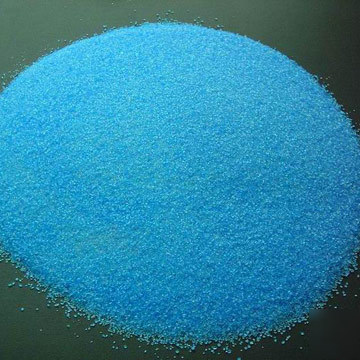Machine Recycling Discussion and Moderated Newsgroup > Components
> Structural Parts
> South
> New
> Copper sulphate sulfate pentahydrate CUSO4 4 lbs(pound)
Copper sulphate sulfate pentahydrate CUSO4 4 lbs(pound)
Copper(II) sulfate is the chemical compound with the formula CuSO4. This salt exists as a series of compounds that differ in their degree of hydration. The anhydrous form is a pale green or gray-white powder, whereas the pentahydrate (CuSO4 5H2O), the most commonly encountered salt, is bright blue. The anhydrous form occurs as a rare mineral known as chalcocyanite. The hydrated copper sulfate occurs in nature as chalcanthite (pentahydrate), and two more rare ones: bonattite (trihydrate) and boothite (heptahydrate). Archaic names for copper(II) sulfate are "blue vitriol" and "bluestone".[1]
Copper(II) sulfate pentahydrate decomposes before melting, losing two water molecules at 63 C, followed by two more at 109 C and the final water molecule at 220 C.[citation needed] At 650 C, copper(II) sulfate decomposes into copper(II) oxide (CuO) and sulfur trioxide (SO3). Its blue color is due to water of hydration. When heated in an open flame the crystals are dehydrated and turn grayish-white.[2]
As a herbicide, fungicide and pesticide
Copper sulfate pentahydrate is a fungicide. Mixed with lime it is called Bordeaux mixture and used to control fungus on grapes, melons, and other berries.[3] Another application is Cheshunt compound, a mixture of copper sulfate and ammonium carbonate used in horticulture to prevent damping off in seedlings. Its use as a herbicide is not agricultural, but instead for control of invasive aquatic plants and the roots of plants near pipes containing water. It is used in swimming pools as an algaecide. A dilute solution of copper sulfate is used to treat aquarium fish for parasitic infections,[4] and is also used to remove snails from aquariums. Copper ions are highly toxic to fish, care must be taken with the dosage. Most species of algae can be controlled with very low concentrations of copper sulfate. Copper sulfate inhibits growth of bacteria such as E. coli.
Several chemical tests utilize copper sulfate. It is used in Fehling's solution and Benedict's solution to test for reducing sugars, which reduce the soluble blue copper(II) sulfate to insoluble red copper(I) oxide. Copper(II) sulfate is also used in the Biuret reagent to test for proteins.
Copper sulfate is also used to test blood for anemia. The blood is tested by dropping it into a solution of copper sulfate of known specific gravity blood which contains sufficient hemoglobin[5] sinks rapidly due to its density, whereas blood which does not, floats or sinks quickly.
In a flame test, its copper ions emit a deep blue-green light, much more blue than the flame test for barium.
Copper sulfate is employed in organic synthesis.[6] The anhydrous salt catalyses the transacetylation in organic synthesis.[7] The hydrated salt reacts with potassium permanganate to give an oxidant for the conversion of primary alcohols.[8]
Copper sulfate is a commonly included chemical in children's chemistry sets and is often used to grow crystals in schools and in copper plating experiments. Due to its toxicity, it is not recommended for small children. Copper sulfate is often used to demonstrate an exothermic reaction, in which steel wool or magnesium ribbon is placed in an aqueous solution of CuSO4. It is used in school chemistry courses to demonstrate the principle of mineral hydration. The pentahydrate form, which is blue, is heated, turning the copper sulfate into the anhydrous form which is white, while the water that was present in the pentahydrate form evaporates. When water is then added to the anhydrous compound, it turns back into the pentahydrate form, regaining its blue color, and is known as blue copperas.[9]
In an illustration of a "single metal replacement reaction," iron is submerged in a solution of copper sulfate. Upon standing, iron dissolves, producing iron(II) sulfate, and copper precipitates.
The copper can also be electroplated to the iron.[citation needed]
Copper sulfate was also used in the past as an emetic.[10] It is now considered too toxic for this use.[11] It is still listed as an antidote in the World Health Organization's ATC code V03.[12]
In 2008, the artist, Roger Hiorns, filled a waterproofed flat (apartment) in London with 75,000 liters of copper sulfate solution. The solution was left to crystallise for several weeks, and the flat was drained, leaving crystal-covered walls, floors and ceilings.
The work is titled Seizure.[13]

